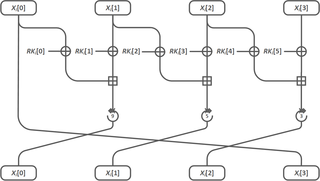(This method was suggested by Bogdanov, Khovratovich and Rechberger in their paper: Biclique Cryptanalysis of the Full AES [1] )
Preliminary:
Remember that the function of the biclique is to map the intermediate values,  , to the ciphertext-values,
, to the ciphertext-values,  , based on the key
, based on the key  such that:
such that:

Procedure:
Step one: An intermediate state( ), a ciphertext(
), a ciphertext( ) and a key(
) and a key( ) is chosen such that:
) is chosen such that:  , where
, where  is the function that maps an intermediate state to a ciphertext using a given key. This is denoted as the base computation.
is the function that maps an intermediate state to a ciphertext using a given key. This is denoted as the base computation.
Step two: Two sets of related keys of size  is chosen. The keys are chosen such that:
is chosen. The keys are chosen such that:
- The first set of keys are keys, which fulfills the following differential-requirements over
 with respect to the base computation:
with respect to the base computation: 
- The second set of keys are keys, which fulfills the following differential-requirements over
 with respect to the base computation:
with respect to the base computation: 
- The keys are chosen such that the trails of the
 - and
- and  -differentials are independent – i.e. they do not share any active non-linear components.
-differentials are independent – i.e. they do not share any active non-linear components.
In other words:
An input difference of 0 should map to an output difference of  under a key difference of
under a key difference of  . All differences are in respect to the base computation.
. All differences are in respect to the base computation.
An input difference of  should map to an output difference of 0 under a key difference of
should map to an output difference of 0 under a key difference of  . All differences are in respect to the base computation.
. All differences are in respect to the base computation.
Step three: Since the trails do not share any non-linear components (such as S-boxes), the trails can be combined to get:
 ,
,
which conforms to the definitions of both the differentials from step 2.
It is trivial to see that the tuple  from the base computation, also conforms by definition to both the differentials, as the differentials are in respect to the base computation. Substituting
from the base computation, also conforms by definition to both the differentials, as the differentials are in respect to the base computation. Substituting 
 into any of the two definitions, will yield
into any of the two definitions, will yield  since
since  and
and  .
.
This means that the tuple of the base computation, can also be XOR'ed to the combined trails: 
Step four: It is trivial to see that:



If this is substituted into the above combined differential trails, the result will be:

Which is the same as the definition, there was earlier had above for a biclique:

It is thus possible to create a biclique of size  (
( since all
since all  keys of the first set of keys, can be combined with the
keys of the first set of keys, can be combined with the  keys from the second set of keys). This means a biclique of size
keys from the second set of keys). This means a biclique of size  can be created using only
can be created using only  computations of the differentials
computations of the differentials  and
and  over
over  . If
. If  for
for  then all of the keys
then all of the keys  will also be different in the biclique.
will also be different in the biclique.
This way is how the biclique is constructed in the leading biclique attack on AES. There are some practical limitations in constructing bicliques with this technique. The longer the biclique is, the more rounds the differential trails has to cover. The diffusion properties of the cipher, thus plays a crucial role in the effectiveness of constructing the biclique.




































































